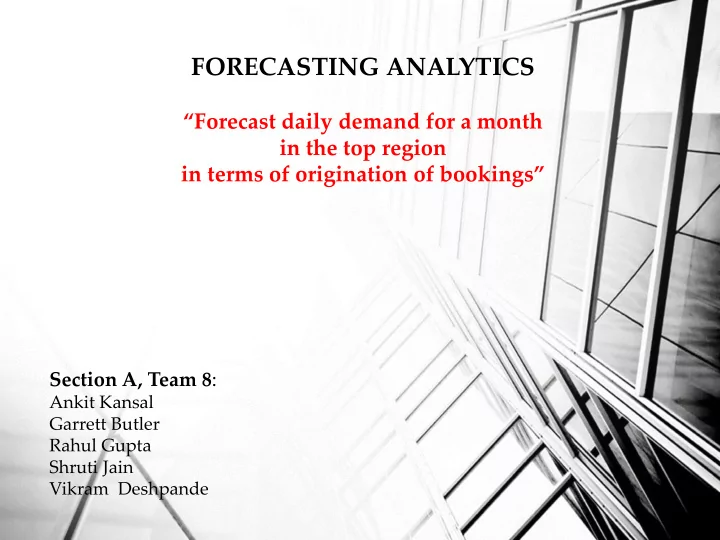

FORECASTING ANALYTICS “Forecast daily demand for a month in the top region in terms of origination of bookings” Section A, Team 8 : Ankit Kansal Garrett Butler Rahul Gupta Shruti Jain Vikram Deshpande
Business Objective To predict the future demand from the top region in the city of Bangalore which will help manage capacity allocation and develop new vendor relationships which are critical to yourcabs ’ business model.
Forecasting Goal • To forecast the daily number of total bookings for yourcabs from the city of Bangalore and then use it to forecast the demand from the top region in terms of bookings • Our time horizon for forecasting the selected series is 4 weeks and the level of granularity is daily data, which we think will provide suitable time to yourcabs to manage regional capacity and manage its vendor relationships.
Region definition 7000 9% Demand as % of total demand 8% 6000 Demand Numbers 7% 5000 6% 4000 5% 4% 3000 3% 2000 2% 1000 1% 0 0% 1 2 3 4 5 6 7 8 9 Regions • Divided the city into 9 regions • Identified the region with based on concentration of highest ratio of total demand demand numbers • Both 1 and 7 have close demand • Each region was assumed to be ratios around 5 km in diameter • We have picked Region 1 (Airport area) for the regional demand forecast
Time-Series Analyzed Total Demand (D) 1. Demand through phone bookings (P) 2. Demand through online site (O) 3. Demand through mobile site (M) 4. Ratio of demand D1 in the top demand 5. region to the total demand D witnessed by yourcabs (R1)
Total demand time plot
Booking from different modes (phone, online and mobile site)
Weekly seasonality in total demand
Forecasted vs actual total demand Method MAPE Naïve 23% Regression + AR(1) 17% Exponential Smoothing 28% Neural 28%
Forecasted vs actual mobile site bookings Forecasting method MAPE Seasonal naïve 66.07% Regression + AR(1) 35%
Forecasted vs actual phone bookings Forecasting method Ensemble RMSE 23.59835 Ensemble MAPE 26.09166 Ensemble – 70% lag_2, 30% NN Naïve RMSE 33.26356 Naïve MAPE 30.91721
Forecasted vs actual online bookings • Holt Winters model is used to capture the • RMSE Model - 35.01717248 • MAPE Model - 48.00089708 local minima and maxima; however, level • RMSE Naïve -44.10863213 remains high • Regression is used to bring down the level • MAPE Naïve 43.90495338 • Naïve model is lag 7
Total aggregated demand vs. total forecasted demand
Region demand
Thank You
Recommend
More recommend